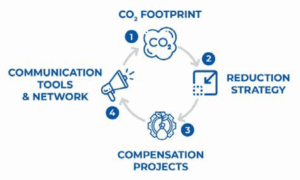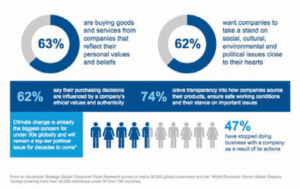Climate Action Commission
No other topic – including COVID-19 – has so much destructive power and polarises so many public and private debates as climate change. Often, half-knowledge and emotions dominate the discussion, while concrete and implementable ideas about what companies can do regarding the duopoly of ecology and economy are often missing. However, the key message can be summarised in less than 20 words:
- It is real.
- We are the cause.
- It is dangerous.
- The experts agree.
- We can still do something.
It is real.
The Earth is currently experiencing an unprecedented accumulation of records. From 1980 to the current year, every decade has been warmer than the previous decade (since records began in 1850). According to data from NASA (National Aeronautics and Space Administration) and NOAA (National Oceanic and Atmospheric Administration), 2019 was the second warmest year in the world since recordings began, and the 43rd consecutive year in which the average temperature on the Earth’s surface was above the twentieth century average. The alarming effects are illustrated by the following examples:
- Since 1900, sea levels have already risen by around 16 cm on average worldwide. Since 2006, the annual rate of increase has been around 3.6 mm, more than double the previous rate.
- The sea ice around the North Pole is shrinking and has steadily declined since satellite measurements began in 1979—by an average of more than 10% per decade.
- The ice shield on Greenland is disappearing by more than 250 billion tons every year and at an accelerated pace: between 1981 and 2010, in the warmest months June and July, it melted on approximately 15%, and on approximately 25% in June and July 2020.
- Most mountain glaciers are also shrinking. The global mass of mountain glaciers has declined significantly since 1980: on average, an ice layer more than 20 m thick has disappeared since then.
- Extreme weather events have increased significantly worldwide, such as number, intensity, and duration of heat waves and droughts.
Climate change is also becoming increasingly noticeable in Germany. The British climate scientist Ed Hawkins made this development comprehensible in his so-called “warming stripes” based on the dataset of the German Weather Service (DWD) for the mean temperature in Germany from 1881 to 2017:

Fig. 1: Climate change in Germany as a colourful barcode (1881–2017)
We are already experiencing more heat and less frost in Germany. In the 1950s, there were about three so-called ‘hot days’ (a temperature of 30 °C or higher) on average nationwide annually. In the period of 1991–2019, the number of hot days increased to an average of 8.8 days per year. During the same period, the average number of so-called ‘ice days’ (a temperature below 0 °C) decreased from 28 to 19 days per year. With current greenhouse gas emissions, a further increase of 5 to 10 hot days in northern Germany and 10 to 15 hot days in southern Germany is predicted for the period of 2021 to 2050.
Many sectors of the economy, such as energy production and industry, are noticing the effects of drought: during the dry years of 2018 and 2019, the water levels of the Rhine and the Elbe fell so badly that inland waterway vessels could only travel to a limited degree for weeks or even months. The economic damage to the affected sectors amounted to hundreds of millions of euros.
Plants and animals are sensitive to global warming. Dry stress to lower summer rainfall, increased water demand due to higher temperatures, the accelerated development of insect pests and the increasing risk of forest fires threaten forestry. After the dry years of 2018 and 2019, at least 285,000 hectares of forest died nationwide—more than five times the area of Lake Constance.
As a result of climate change, sea levels on Germany’s coasts are also rising. In Cuxhaven, for example, the relative sea level has already increased by a good 40 cm since the middle of the nineteenth century.
We are the cause.
All components of the climate system, i.e. ocean, land, atmosphere, biosphere and ice masses, have warmed significantly in recent decades—virtually everywhere on Earth. Currently, scientists are talking about a warming of 1.2 °C as a global average. The rapid pace and global simultaneity of temperature rise distinguish today’s man-made climate change from natural changes, such as the Ice Age warm-time cycles or the so-called Medieval Warm Time.
Scientists exclude natural causes as a reason for the current, very rapid and steep rise in temperature since the beginning of industrialisation. It can only be explained by the man-made reinforcement of the greenhouse effect. The sun drops out as the cause, as its luminosity has been declining slightly for about 50 years—while, at the same time, the strongest temperature increase was measured during this period.

It is dangerous.
So what about the scientific facts? Do some of the above facts not sound a little exaggerated in their own right? Why all the buzz about 1.2 °C, 1.5 °C or 2 °C?
The 1.5 °C limit is by far missed in current policies and regulations: with continued emissions, the average global warming could be more than 4 °C by the end of the century. At the UN climate summit in Paris in 2015, it was decided that the global temperature increase should be limited to ‘well below 2 °C’ compared to pre-industrial levels and, if possible, even to 1.5 °C. If the current warming trend continues, this limit could be exceeded in just over a decade.
In addition, some elements of the Earth’s climate system do not change gradually but in leaps and bounds as the temperature rises. In this context, scientists speak of tipping points and have identified more than a dozen of them; when reached, a return to the previous state is practically impossible.
One example is the ice sheet on Greenland: it is currently several kilometres thick, so that the surface is at a height where it is much cooler (as in the mountains). If it melts, the surface sinks into warmer air layers, which leads to an acceleration of the melting process. For the ice mass to theoretically grow again, temperatures on Earth would have to drop to levels like those of the last ice age (and thus by around 4 °C on a global average compared to today). Other tipping points include melting of the Antarctic ice sheet, destruction of the Amazon rainforest, death to tropical coral reefs and thawing of the permafrost soils, which could release huge amounts of methane and CO2 This is why the speed of effective climate action is crucial and why the buzz about every tenth of a degree is indeed justified—and crucial to the survival of all human beings and animals on our planet.
Although the EU has declared a climate emergency, climate protection legislation in Europe, as in Germany, has been completely inadequate so far: the switch to innovative technologies, the polluter-paid pricing of CO2 and the reduction of subsidies to fossil fuels are being delayed. Even if all countries achieve their self-set, individual goals promised in the 2015 Paris agreement on climate change, the earth will still warm by about 3 °C. The climate protection targets defined in both Germany and the EU themselves miss the 2° target, which has also not been met in the past.
The experts agree.
Almost everyone knows the much-quoted ‘97%-of-all-scientist-believe-in-the-anthropogenic-climate change’ statement. If you dig deeper, you will find countless serious studies and reports by climate scientists, such as climatologists, meteorologists, geologists, oceanologists and physicists, who overwhelmingly publish further views and results that correspond to or supplement the statement made above.
There is no doubt that there are also experts among politicians who, within the scope of their tasks and responsibilities, have had first-hand access to all scientific facts, scenarios and model calculations for decades: there are now finally a few politicians among the political parties that are committed to democratic principles who do not speak out clearly about the existence of a climate crisis and the need for consistent action. Nonetheless, while instruments exist to prevent the climate crisis (such as CO2 tariffs or market-ready innovations in the fields of photovoltaics or green hydrogen), there are neither sufficient incentives nor regulations by politicians to finally implement the needed measures.
We can still do something.
Although it is undoubtedly a major challenge, it is possible to reduce greenhouse gas emissions quickly and drastically! Many of the technologies required for this purpose exist and are in some cases already financially competitive or even cheaper. Several countries have significantly reduced their greenhouse gas emissions in recent years—in some cases, much more than Germany: Denmark or the United Kingdom, for example, succeeded in reducing emissions by more than a third between 2005 and 2017, whereas Germany’s reduction of 13.58% was well below the required level of ambition.
On the one hand, there is a lack of sensible, action-oriented regulatory regulations and, on the other hand, consumers are paying more attention to sustainable products and climate-friendly companies—this provides companies with voluntary measures for more climate protection and an important lever in their hands. There is a rapidly growing number of innovative companies who start right here, i.e. they do not wait for politics and consistently focus their company on sustainability in order to reduce their CO2 footprint to net zero as quickly as possible. The motivation for most is to preserve the beauty of our earth for the generation of our children and grandchildren. Many have also understood that this will have a positive effect on sales, customer loyalty and, ultimately, company value.
The vision of implementing net zero for all countries of the world is as complex as it is necessary. Planning and implementing climate protection for a single company is comparatively easy. Above all, it requires:
- The will and a quantified objective to reduce CO2 emissions in their company, based on voluntary measures, at best to net zero.
- Knowledge of the starting point, i.e. the quantities of CO2 produced today in their company and their respective sources, in the form of a CO2 footprint.
- An effective plan to reduce or, better still, avoid CO2 emissions in their company and its value chain over time.
- The willingness to net zero emissions and to compensate for the remaining annual amounts of CO2 via high-quality and validated CO2 allowances.
Professional climate consultants, such as Climate Partner, Focus Future or Go.Blue.Now., support companies in these steps with workshops and individual advice from qualified employees, tested tools and methods, partners and networks as well as a lot of passion and experience.
The strategic and economic importance of climate protection measures at the company level has now also been recognized by the major management consultants. For example, McKinsey & Company emphasize the need for companies to proactively engage in environmental, societal and sustainability topics (ESG for environment, society, governance) and to position themselves against different stakeholders, such as customers, employees, suppliers and municipalities. In a recent study, Accenture highlights that consumers are no longer only looking at the quality and price of products and services for their purchasing decisions, but also at the consistency with their own values and basic views, also—and especially—in the context of climate protection:


When companies start now for climate neutrality, they gain a measurable competitive advantage by the label ‘climate neutral’, and they have a head start by implementing necessary change processes in the company with measurable advantages:
- By visibly differentiating their brand and products, they attract new customers, as well as increase innovative strength and competitiveness.
- As their reputation for climate protection and sustainability grows, the trust and loyalty of their customers increase and, over time, so does their customer lifetime value (CLV).
- Their corporate culture radiates meaning and satisfaction, thus increasing the attractiveness for new and existing employees.
Finally, these companies are well equipped for the already foreseeable political climate protection targets for companies that are to come imminently.
Jörg Tuchen
Chair Climate Action Commission,
EU Tech Chamber






















